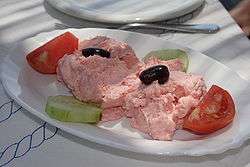Taramasalata
|
| |
| Type | Dip |
|---|---|
| Course | Meze |
| Place of origin | Greece |
| Main ingredients | Taramas (salted and cured roe of cod or carp), bread crumbs or mashed potatoes, lemon juice or vinegar, olive oil |
|
| |
Taramasalata or taramosalata (Greek: ταραμοσαλάτα, from taramas, from Turkish: tarama 'fish roe'[1] + salata, from Italian: insalata "salad"[2]) is a Greek and Turkish meze made from tarama, the salted and cured roe of the cod, carp, or grey mullet (bottarga) mixed with olive oil, lemon juice, and a starchy base of bread or potatoes, or sometimes almonds. Variants may include garlic, spring onions, or peppers, or vinegar instead of lemon juice.[3][4]
Taramosalata is usually eaten as a meze, a dip for bread or raw vegetables. The color can vary from creamy beige to pink, depending on the type of roe used. Most tarama in commerce is dyed pink. However, high quality taramosalata is always beige in colour.[3]
Mass-produced prepared taramasalata is often a bright pink due to the addition of food coloring and low-cost ingredients. This type of taramosalata is a cheap alternative to the original, often containing only small quantities of roe and various fillers.
In Greece, taramasalata is associated with Clean Monday (Καθαρά Δευτέρα, Kathará Deutéra), the first day of Great Lent.
Name and spelling
Normally, tarama is the salted roe itself, but sometimes the prepared dish is also called tarama.[4]
The spelling taramosalata reflects the Greek, but in English the a spelling is common.[5]
Salată de icre

.jpg)
A similar dip or spread, salată de icre ('roe salad' in Romanian) is also common in Romania and Bulgaria (known as хайвер, or haiver). It is made with pike or carp roe but generally with sunflower or vegetable oil instead of olive oil, sometimes with a thickener like white bread. It is mass-produced and is widely available in grocery shops and supermarkets, as well as being made at home, in which case chopped onions are commonly added.
A version of this dip is prepared with mashed beans, sunflower oil, garlic and chopped onions, called fasole bătută or fasole făcăluită (mashed beans) or icre de fasole (beans roe).[6]
See also
References
- ↑ "tarama". İlhan Ayverdi (2005). Misalli Büyük Türkçe Sözlük. 3 O–Z. Kubbealtı. p. 3069. ISBN 975-6444-24-X.
- ↑ "taramasalata". The American Heritage Dictionary of the English Language. Houghton Mifflin Company.
- 1 2 Diane Kochilas, "Greek Food Info", Tarama
- 1 2 Ghillie Basan, Jonathan Basan, Classic Turkish Cooking, ISBN 0312156170, p. 68
- ↑ -a- is the only spelling given in The Macquarie Dictionary (1995) for Australian English and in Chambers Dictionary (1994), Collins English Dictionary 6th Edition (2003), Concise Oxford Dictionary 9th Edition (1995), and The Times English Dictionary (2000), all of which represent British English but indicate alternate American spellings and indicate nothing here. -o- is also given, but second so that -a- is preferred, by Longman Dictionary of the English Language (1988) (British publisher). The word was not given at all a few decades ago such as in [Merriam-]Webster's New Collegiate Dictionary (1977) or their three-volume 3rd International (1971) and is now given with -a- in The American Heritage Dictionary, see note above.
- ↑ "Précarité alimentaire, austérité / Food insecurity and austerity". Manger pendant la dernière décennie communiste en Roumanie / Eating in the last decade of communism in Roumania (in French). Catherina Perianu. Retrieved 2012-02-24.


